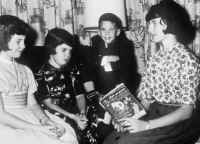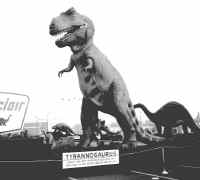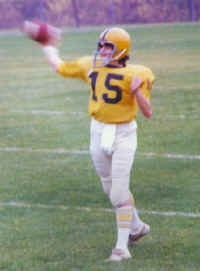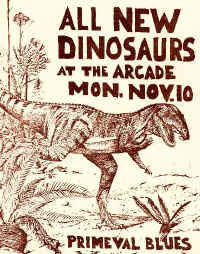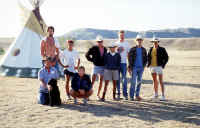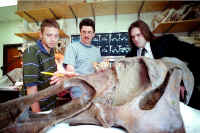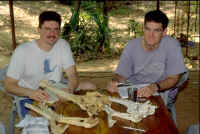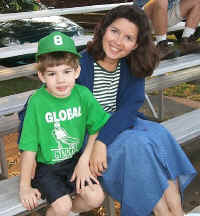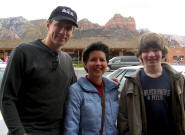- News & information
- About
- History
- George V. Voinovich
- George V. Voinovich Collection
- Calendar
- How to Find Us
- News
- Archives
- Photojournalism Fellowship Project
- Photo Essays
- Current Fellow
- Previous Fellows
- Reports and Publications
- Archives
- Students
- Prospective
- Center for Entrepreneurship
- Environmental Studies
- HTC/Voinovich School Scholars
- Master of Public Administration
- Current
- HTC/Voinovich School Scholars
- Center for Entrepreneurship
- Environmental Studies
- Master of Public Administration
- Alumni
- Contact
- School Leadership
- Strategic Partners Alliance
- Ohio University Public Affairs Advisory Committee
- Ohio University Public Affairs Advisory Committee
- Faculty and Fellows
- Faculty
- Visiting Professors
- Voinovich Fellows
- Professional Staff
| Lawrence M. Witmer,
PhD
|
Biographical
Narrative
Preface.—
The purpose of this narrative is to describe my path
to academia.Its intent is
ostensibly to provide background for prospective students and my
professional friends and colleagues, and to acknowledge those people and events that have
influenced my professional development.But beyond that, as my scientific mission has been to “flesh
out” animals of the past, so do I here seek to flesh out my own past.Ultimately, it’s been fun to reflect on my own
evolutionary history for once and to assemble these thoughts.
The
early years.—
I was born into a loving home in Rochester, New
York, in the late 1950’s, where, as the youngest of four children and
only boy, I probably was indulged more than was healthy (perhaps as
amply attested by the indulgence of this narrative).Nevertheless, I had a happy and healthy middle-class suburban
upbringing.Like many
scientists of all stripes (and folks in general), my first exposure to
science was through the world of dinosaurs.Unlike many scientists, my passion for dinosaurs and their kin
never waned.A very
important early influence was the traveling exhibit of life-size
dinosaur reconstructions put on by the Sinclair Oil Company (originally
part of the World’s Fair).Likewise,
the books of Edwin H. Colbert— Men and Dinosaurs
, The Age of
Reptiles
, etc.—were books I read over and over again.I recently found my original copy of Roy Chapman Andrews’ All
About Dinosaurs
, the classic account of the Central Asiatic
Expeditions; not only was it well-thumbed but (I shouldn’t admit it)
had highlighting and marginal notes.Throughout my childhood, I studied other areas of science (how
could a child not have been captivated by the drama of the Gemini and
Apollo missions?) and even branched out into comparative literature, but
the evolutionary history of life on Earth was a consistent draw.
Of course, as adolescence advanced, my
interests strayed to sports, cars, and girls—although
I have to admit that I did better in the first two than
the third (I lettered in football, basketball, track,
and tennis, and my 1969 burgundy Firebird convertible
will never be matched).Nevertheless,
I managed to maintain sufficient academic focus to
graduate from James E. Sperry High School as
salutatorian in 1977.I need to acknowledge the importance of my high school Earth
Sciences teacher—one of those unsung but pivotal
individuals one encounters in public school: Don Shultz
cultivated my interests in paleontology and introduced
me to the joys of amateur fossil collecting.Mr. Shultz would routinely pull a fossil from his pocket and
offer that “If I could identify it, I could have it,”
where after I would run to technical sources and
discover the name of the beast.
Higher education.—
In
the fall of 1977 I entered Cornell University in Ithaca, New York.I started out as a Biology/Geology double major, but soon
realized that these majors were in different colleges, each of which had
formidable requirements.Always
(and still) a biologist at heart, I settled on biology.Nevertheless, I still took all the “soft rock” courses in the
geology department, and John Cisne (Cornell’s invertebrate
paleontologist) was a big influence, as was paleobotanist Karl Niklas.Without question, the most important course I took at Cornell,
was Mammalogy, and not because of the course content, but because it was
there that I met Patty Morris, the love of my life.“Hey, how ‘bout those bats?” Not the smoothest pick-up
line, but those were my first words to Patty outside of class, in
reference to the live bats exhibited in that morning’s class.It must have worked because we’re still together!My Cornell years involved other pursuits, including Frisbee, the
Grateful Dead, and a series of bands in which I was lead guitar and
vocalist.One of these
bands was a blues band that took the name of a Bill Stout book,
All
New Dinosaurs
,
that happened to be sitting on my coffee table after a rehearsal; the
name seemed apt since we were putting a new spin on old blues tunes that
most folks thought were long extinct.Patty and I were married in 1982 just after graduation, and we
remained the next year in Ithaca, just hanging out and having fun.
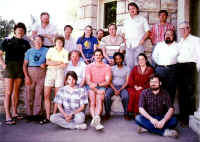 In 1983 I started a masters degree program at the University of
Kansas in Lawrence, under the direction of Larry Martin.KU was in something of a graduate school “golden age” at the
time, and I hesitate to list for fear of omission the many now renowned
people I associated with there in both VP, Herpetology, and elsewhere.It was an exciting time, and much of my present philosophy and
work ethic I owe to the examples posed by those other KU grad students.I also owe a huge debt to Larry Martin, who got me interested in
so many things.He always
encouraged me to look at modern animals along side extinct groups, and
this has emerged as my major research paradigm, these nascent ideas
later evolving into the extant phylogenetic bracket approach.And of course it was Larry who introduced me to the previously
under-appreciated anatomical system of cephalic pneumaticity, which
became my major research focus for a decade and a half.Although Larry and I are often now pitted as opponents in the
fierce debate on avian origins, he has been one of the most important
positive influences in my career.While
at KU, I learned a trade (at least that’s how I viewed it then),
namely that of teaching human gross anatomy.I was a teaching assistant for six semesters during my four years
at KU.Despite the
wonderful training in comparative biology I was getting at Kansas, I was
convinced that it was human anatomy that was going to get me a job.Thus, when it came time for shopping for a PhD program, I was
quite mercenary (and not a little cynical) in seeking only “big-name
East Coast schools” where I could enhance my human anatomy teaching
credentials.In retrospect,
it worked out well, but as an explicit plan it all seems quite
distasteful now.
In 1983 I started a masters degree program at the University of
Kansas in Lawrence, under the direction of Larry Martin.KU was in something of a graduate school “golden age” at the
time, and I hesitate to list for fear of omission the many now renowned
people I associated with there in both VP, Herpetology, and elsewhere.It was an exciting time, and much of my present philosophy and
work ethic I owe to the examples posed by those other KU grad students.I also owe a huge debt to Larry Martin, who got me interested in
so many things.He always
encouraged me to look at modern animals along side extinct groups, and
this has emerged as my major research paradigm, these nascent ideas
later evolving into the extant phylogenetic bracket approach.And of course it was Larry who introduced me to the previously
under-appreciated anatomical system of cephalic pneumaticity, which
became my major research focus for a decade and a half.Although Larry and I are often now pitted as opponents in the
fierce debate on avian origins, he has been one of the most important
positive influences in my career.While
at KU, I learned a trade (at least that’s how I viewed it then),
namely that of teaching human gross anatomy.I was a teaching assistant for six semesters during my four years
at KU.Despite the
wonderful training in comparative biology I was getting at Kansas, I was
convinced that it was human anatomy that was going to get me a job.Thus, when it came time for shopping for a PhD program, I was
quite mercenary (and not a little cynical) in seeking only “big-name
East Coast schools” where I could enhance my human anatomy teaching
credentials.In retrospect,
it worked out well, but as an explicit plan it all seems quite
distasteful now.In 1987, we left Kansas for Baltimore and the
doctoral program at the Johns Hopkins School of Medicine.I left with those “credentials” I had sought, but I got
so much more along the way.Hopkins
Med School was a world away from the KU Museum.It is very much a medical environment and located in an often
dangerous urban setting.At
the time, the Functional Anatomy and Evolution program was very young
and the course offerings consisted primarily of the first-year medical
curriculum.Although this seemed inappropriate to me at first, I quickly
saw that this background in medical physiology, histology, molecular
biology, and biochemistry greatly enhanced my marketable training, and
started me down the road to medical education that I continue today.But beyond that, it clearly made me a better evolutionary
biologist.It was at
Hopkins that I made the seemingly paradoxical observation that many of
the most sophisticated and rigorous paleontologists had medical gross
anatomy training and were located at med schools, not museums.Although I was clearly plotting my job-hunting strategy, I gained
new perspectives and approaches at Hopkins.Most influential was my PhD advisor and mentor Dave Weishampel,
who, in addition to an encyclopedic knowledge of dinosaurs, is
interested in the conceptual basis of his science.For example, Dave introduced me to the conceptual framework
offered by the German school of Constructional Morphology.He also showed me that dinosaur functional morphology could be
scientific, quantitative, and cutting-edge.In fact, in general I came away from Hopkins with both training
in and a stronger appreciation for biomechanics, morphometrics, and
quantitative biology.I was
also able to participate in Dave’s field program in the St. Mary River
Formation of Montana—two wonderful seasons in the Late Cretaceous.I would have liked to spend additional seasons, but then, as now,
my scientific questions have not been faunistic or requiring
paleontological fieldwork.My trips to Louisiana to work on alligators are more reflective of the
kind of field experiences I can justify now.In general, my five years at Hopkins were a time to crank on
publications and my dissertation (I had a fellowship and hence minimal
teaching responsibilities), and to plan my future professional course.
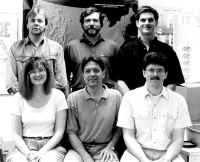 The professional years.—
Having
spent nine years in graduate school, the thought of additional years of
postdoctoral training was not too enticing.Thus, I directed my efforts at getting a job—an academic,
preferably tenure-track, assistant professorship.Job hunting while finishing one’s doctoral dissertation is not
optimal for a variety of reasons, not least of which is that most search
committees want to see that that PhD is truly done and in hand.Consequently, my initial applications were unsuccessful.As they say, if you can’t be good, be lucky—and I got lucky.The New York College of Osteopathic Medicine (NYCOM) on Long
Island had lost a faculty member at a late date and needed an anatomist.Fortunately, a colleague from Hopkins, Nikos Solounias, was a new
faculty member at NYCOM, and alerted me to the position.I had the “credentials, ” I had the teaching experience, and
I had the inside track (thanks to Nikos), and I got the job.One little detail: I had to actually finish my dissertation on
time.The transition
(mid-August, 1992) was a blur: we moved to Long Island on a Saturday,
returned to Baltimore on Sunday, I defended my dissertation on
Wednesday, revised it on Thursday, turned it in on Friday, made the
final move to Long Island on Sunday, and started work at NYCOM at 9AM
Monday morning—oh, and Patty was five-months pregnant!
The professional years.—
Having
spent nine years in graduate school, the thought of additional years of
postdoctoral training was not too enticing.Thus, I directed my efforts at getting a job—an academic,
preferably tenure-track, assistant professorship.Job hunting while finishing one’s doctoral dissertation is not
optimal for a variety of reasons, not least of which is that most search
committees want to see that that PhD is truly done and in hand.Consequently, my initial applications were unsuccessful.As they say, if you can’t be good, be lucky—and I got lucky.The New York College of Osteopathic Medicine (NYCOM) on Long
Island had lost a faculty member at a late date and needed an anatomist.Fortunately, a colleague from Hopkins, Nikos Solounias, was a new
faculty member at NYCOM, and alerted me to the position.I had the “credentials, ” I had the teaching experience, and
I had the inside track (thanks to Nikos), and I got the job.One little detail: I had to actually finish my dissertation on
time.The transition
(mid-August, 1992) was a blur: we moved to Long Island on a Saturday,
returned to Baltimore on Sunday, I defended my dissertation on
Wednesday, revised it on Thursday, turned it in on Friday, made the
final move to Long Island on Sunday, and started work at NYCOM at 9AM
Monday morning—oh, and Patty was five-months pregnant!I spent three very important years at NYCOM—important
in that they very much changed my sense of my career.Although I always regarded my NYCOM position as short-term, I nonetheless embraced the job and became involved and
interested in medical education.At
NYCOM I discovered the business of academia.Being a professor, I found, is much more than research and
teaching.I quickly learned
the requisite skills of departmental politics, memo-writing, wrangling
about space, staffing, purchasing, and all sorts of other tasks that I
never envisioned doing in my ivory tower of Academe.At NYCOM, I more-or-less grew up, professionally speaking.Still, there was ample research time, and I was able to crank on
various projects for months at a time.NYCOM is very well positioned geographically, being less than an
hour from New York City (and the AmericanMuseum of Natural History where I was made a Research Associate)
and is more or less equidistant from Boston and Washington, DC; thus,
most of the best natural history collections in North America were
within a four-hour radius.But
the real joy of NYCOM was my colleagues, in particular my old friend
Nikos and, later, Scott Sampson and Des Maxwell, with all of whom I
still work closely.Scott
and Des have both since left NYCOM.In particular, Scott and I developed a research partnership that
will continue to bear fruit well into the foreseeable future.More importantly perhaps, Scott has become one of my closest
friends and most trusted colleagues.
For Patty and me, our Long Island years are
especially treasured in that it was on “The Island” that our son Sam
was born in 1993.We loved
the beaches, the parks, and the libraries, and we will always have fond
memories of taking Sam to those places.But we never truly felt at home on Long Island, and the cost of
living was simply too high for a family living on a college
professor’s wages.Thus,
I interviewed for other academic positions every year I was at NYCOM.
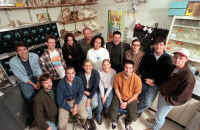 In 1995, I accepted an offer from the
Ohio University Heritage College of Osteopathic Medicine (OU-HCOM) to join
the faculty and become a player in a ground-breaking new
curricular track, the PCC (a Patient-Centered Continuum).The
PCC, just a year old when I arrived, is a problem-based learning
curriculum revolving around real clinical cases.My role has been to coordinate the anatomical experiences for the
PCC students.OU-HCOM
is one of the most innovative and ambitious places I’ve heard
of, let alone worked in.Consequently, it’s a truly exciting environment, and I’m
surrounded by competent and committed people.Since 1997, I’ve expanded my educational mission out past
medical school to the residency years, and I coordinate basic
science education for the General Surgery and Pediatric
residency programs for the consortium of osteopathic hospitals
in the state of Ohio.This strong emphasis in medical education would seem to contrast
sharply with a research program in the evolutionary biology of
dinosaurs and other vertebrates…and it does—big time.My hospital-based medical colleagues have no inkling of my
paleontological research unless they happen to see something
about me in the newspaper.Likewise,
my scientific colleagues are usually aghast when they hear of
the extent of my involvement in medical education.It somehow works for me.I’m
certainly never bored.
In 1995, I accepted an offer from the
Ohio University Heritage College of Osteopathic Medicine (OU-HCOM) to join
the faculty and become a player in a ground-breaking new
curricular track, the PCC (a Patient-Centered Continuum).The
PCC, just a year old when I arrived, is a problem-based learning
curriculum revolving around real clinical cases.My role has been to coordinate the anatomical experiences for the
PCC students.OU-HCOM
is one of the most innovative and ambitious places I’ve heard
of, let alone worked in.Consequently, it’s a truly exciting environment, and I’m
surrounded by competent and committed people.Since 1997, I’ve expanded my educational mission out past
medical school to the residency years, and I coordinate basic
science education for the General Surgery and Pediatric
residency programs for the consortium of osteopathic hospitals
in the state of Ohio.This strong emphasis in medical education would seem to contrast
sharply with a research program in the evolutionary biology of
dinosaurs and other vertebrates…and it does—big time.My hospital-based medical colleagues have no inkling of my
paleontological research unless they happen to see something
about me in the newspaper.Likewise,
my scientific colleagues are usually aghast when they hear of
the extent of my involvement in medical education.It somehow works for me.I’m
certainly never bored.Apart from the challenges and rewards of medical
education, I’m part of a thriving program in Ecology and Evolutionary
Biology with a large group of motivated young faculty that are bringing
acclaim to themselves, the EEB program, and Ohio University.In particular, our evolutionary functional morphology group has
really gelled in recent years.The
core of this group consists of Audrone Biknevicius (an old friend from
Hopkins when we were grad students together), Steve Reilly, Pat
O'Connor, Susan Williams, Nancy Stevens, and our
collective students.We have developed a productive synergy borne of frequent and
friendly interaction and collaboration.Graduate students have become a
major part of my academic life, and my lab is rarely a quiet place. The
various research projects in the lab have expanded into many fascinating areas involving many different people.Many days I feel more like a project administrator than a
scientist, trying to keep all the varied facets of the larger project
supplied, funded, and moving forward.
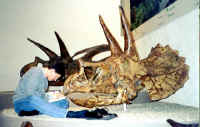 Postscript.—
When I was six years
old I wanted to be a professional paleontologist.Of course, when I was seven I wanted to be a snowman, but, other
than that brief detour, my course has been fairly unwavering.(Okay, there was that musician thing in college, but that was
about as likely as the snowman career.)I always had a passion for science and found a way to make a
living of it.Some days I
think, “What a scam!They
actually pay me to do this stuff!”Other days, mired in the banality of answering emails and
shuffling papers, I look wistfully out to the lab where my students are
gleefully lost in the joy of scientific discovery.I realize that, in a sense, the occasional tedium of academia is
the “cost of doing business” for those exciting moments of
inspiration and insight.But,
moreover, the other parts of the job carry their own rewards.In particular, teaching future physicians has emerged as one of
the most satisfying parts of my job.And even the administration and committee work impart a sense of
service and of being a part of a larger mission.Along the road to this professional career, many people have
helped me, inspired me, supported me, and set me straight.Many of them are acknowledged here.Of these, my parents—Mel and Barbara Witmer—and my wife Patty
have been my staunch supporters as well the role models for my
professional (and personal) conduct.To them, and to my son Sam, I dedicate my future career.
Postscript.—
When I was six years
old I wanted to be a professional paleontologist.Of course, when I was seven I wanted to be a snowman, but, other
than that brief detour, my course has been fairly unwavering.(Okay, there was that musician thing in college, but that was
about as likely as the snowman career.)I always had a passion for science and found a way to make a
living of it.Some days I
think, “What a scam!They
actually pay me to do this stuff!”Other days, mired in the banality of answering emails and
shuffling papers, I look wistfully out to the lab where my students are
gleefully lost in the joy of scientific discovery.I realize that, in a sense, the occasional tedium of academia is
the “cost of doing business” for those exciting moments of
inspiration and insight.But,
moreover, the other parts of the job carry their own rewards.In particular, teaching future physicians has emerged as one of
the most satisfying parts of my job.And even the administration and committee work impart a sense of
service and of being a part of a larger mission.Along the road to this professional career, many people have
helped me, inspired me, supported me, and set me straight.Many of them are acknowledged here.Of these, my parents—Mel and Barbara Witmer—and my wife Patty
have been my staunch supporters as well the role models for my
professional (and personal) conduct.To them, and to my son Sam, I dedicate my future career.Contact Information:
(740) 593–9381 | Building 21, The Ridges
Ohio University Contact Information:
Ohio University | Athens OH 45701 | 740.593.1000 ADA Compliance | © 2018 Ohio University . All rights reserved.









